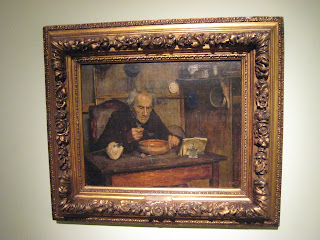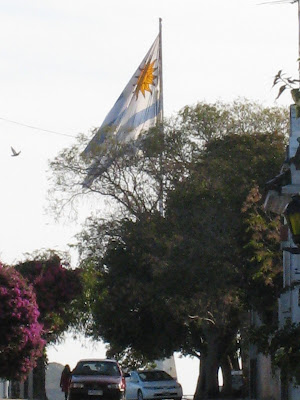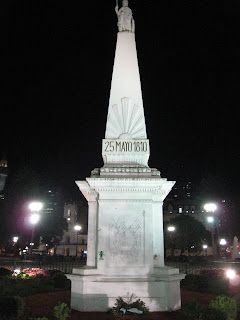
As I sensed the feeling of wind blowing through my hair and the horse's body bumping up and down under my body, I knew that I was no longer in the city of Buenos Aires. In fact, I had come out to a rural town of Argentina called Capilla del Señor to spend the weekend with a couple of friends at an estancia named El Cencerro. Estancias are large, family-owned working farms in the Argentine countryside region known as The Pampas. These farms used to be the main source of food production for the country as guachos (the equivalent of US cowboys) rode through the fields on horseback rounding up cows for slaughter to be turned into the finest steaks in the world. For more information about gauchos, see:
http://en.wikipedia.org/wiki/Gaucho.
Today, gauchos still exist, and estancias still operate, sending food products to markets around the world, but gauchos and estancias no longer occupy the same prominent spot that they used to in world agriculture. In any case, if nothing else, they make for a great escape from the hustle and bustle of Buenos Aires for locals and tourists alike!
Our trip got off to an ominous start, as many of my best adventures have here in South America. We showed up for our shuttle (which would have taken us directly to Capilla del Señor) literally 3 minutes late and missed it. As a result, we had to take a taxi to the bus depot, take a long-distance bus from Buenos Aires to San Antonio de Areco (a larger town about 45 minutes away from Capilla), and then hire a remise (for the equivalent of about $32) to take us to Capilla.
Upon arrival at the bus station in San Antonio, I was pleasantly surprised to find that things had changed drastically from the surroundings I was used to. For one thing, I looked out the window of the bus as we approached the station, and I didn't see any pharmacies, street vendors, or smog. Nope--this clearly wasn't Buenos Airs. After we got off the bus, I purchased a very nice deli sandwich from an old man who had a total of three sandwiches, a few drinks, and a bunch of candy and other smaller items for sale in a box for a total of only 6 pesos ($1.59)! And what's better yet, I didn't even get sick! Then, when we got in the remise (long-distance taxi), I told the driver that we knew the name of the town we were going to but didn't know the address of the estancia because it actually (believe it or not) did not HAVE an address. Not to worry, said the pleasant Argentine driver, we can just ask someone where it is when we get to town. 45 minutes later, we were pulling over and asking for directions every few minutes, and each time, each of the kindly pedestrians responded very positively and excitedly (though sometimes incorrectly). An hour later, we were there!
To sum things up, life was clearly more, "tranquilo."
Out from the ranch house came the owners of the estancia, Eduardo and Lili, to greet us. They showed us around the 500+ acres of their property, gave us a tour of their lovely home that we would be staying in, and brought us to our rooms. Then, after asking us if we were hungry for some lunch, they served up empanadas and a delicious meat dish for us to enjoy. After our tasty meal, the three of us went for a stroll along the creek that runs in the back of El Cencerro. Just sitting in the dirt bank and looking out at the beautiful rays of the sun as they struck the grass, the trees, and the water, was everything I had hoped for in my escape from Buenos Aires, and more than I had expected.

After our leisurely stroll, it was time for a ride around the property on horseback led by a 12-year-old boy who works on the farm with the rest of his family. The boy was certainly a bit of a show-off, showing us how he could ride backward on the horse, how he could chase the other animals away with his horse, and bragging about how he was a better rider than his siblings, but the tour he gave was superb. It has been about 8 years since I had last ridden horseback, but I had a good time with "Llamame," my horse pictured here.
After our ride, it was time for afternoon tea and coffee with pastries, followed up by games of a modified version of Pictionary and Egyptian Ratscrew before and after dinner, respectively. Milanese was served for dinner (an Argentine classic) along with dulce de leche for dessert (definitely my favorite Argentine food item), and then it was time for some evening reading. As I walked down the hall to my room to go to bed, I noticed that the fire in the hallway furnace had gone out, but the fireplace in my room was still crackling, alive. I buried myself away under layers and layers of blankets (there was no heat in the home except the fireplaces in the rooms and miniature furnaces in the hallways, along with some space heaters), and I fell asleep.
The following morning, I arose to a breakfast of tea and coffee with pastries. Then, it was time to explore the historic town of Capilla del Señor. How would we get there? I suggested that we bike, and one of the employees helped us get three old, banged up bikes out of the garage and prepared for the ride. I asked if they had a lock that we could borrow, and they practically laughed! Just drop your bikes by the service station, they said, and there would be no problem. And there wasn't!

As we road through the unpaved gravel roads to the heart of town, we were pursued the entire way by two of the family's dogs trotting alongside our bikes at a comfortable gallop. I couldn't help thinking to myself, "I can't believe I'm here. In South America. In Argentina. On a country road. Riding a bike with the company of two of my friends and two dogs." This was just one of so many experiences that I have had this summer that I never would have dreamed possible before going to college, but it struck me particularly strongly at this time. Once we got to the town, we visited a museum, a historic church, a couple of historic houses, and a few other sites of interest. The town had a certain charm to it that only a place untouched by time can have. Unfortunately, one of the two dogs left us when we went into the Tourist Information Office, and we were never able to find him. As of when we left the estancia later that day, he had not yet returned home, and we all felt terrible about the loss...

When we returned from town, I read for awhile in the hammock and then watched as some of the workers prepared the asado by first building a big fire, then warming stones in the fire, and finally placing the stones under the grill to cook up the steak (which included the intestines, the tastiest part to me!). Everything was absolutely delicious, and it was made even better by the fact that we got to enjoy it with our two gracious hosts who talked to us about everything from politics and current events to dogs to our lives and our work. I would HIGHLY recommend staying at El Cencerro to anybody visiting Argentina!
Finally (and sadly) it was time to return to Buenos Aires. I should have known my good luck would come to an end. I mean this is me and Argentina after all, and if you have been reading any of my previous posts, you will know that I haven't always had the best luck. This time, the form of bad luck came first in not having enough coins for the bus, which would not except bills. The next bus out of Capilla was not going to leave for another hour, and we thought we were stuck! But then, some of the nicest people I have ever met came to ou

r rescue. A man leaned out the window of the bus, hearing our conversation, and said he wasn't sure how much we needed but that he had a single one peso coin left and that he would be happy to give it to us to help us out. I returned to my friends, grateful to get the coin, only to find out that another gentleman had offered them over 9 pesos in bus fair on his card. The warmth and kindness that we received from all the people we encountered in the countryside stood out in stark contrast to what I have encountered in the city, and it served as a nice reminder of the true heart and soul of Argentinians.
Still, more bad luck was to come. About 40 minutes out of Capilla, our bus broke down (pictured above, right). We were stranded on the side of the highway for about 20 minutes before another bus picked us up and finally carried us home to Buenos Aires. Still, I had a great conversation (in Spanish) with another rider during the time that we were waiting for the new bus to come. A part of me wished that they wouldn't have been able to get another bus and that we would have had to return to Capilla for another night at Eduardo's and Lili's home. I guess it was not in the cards. . . . I guess it was just my bad luck again!



















































